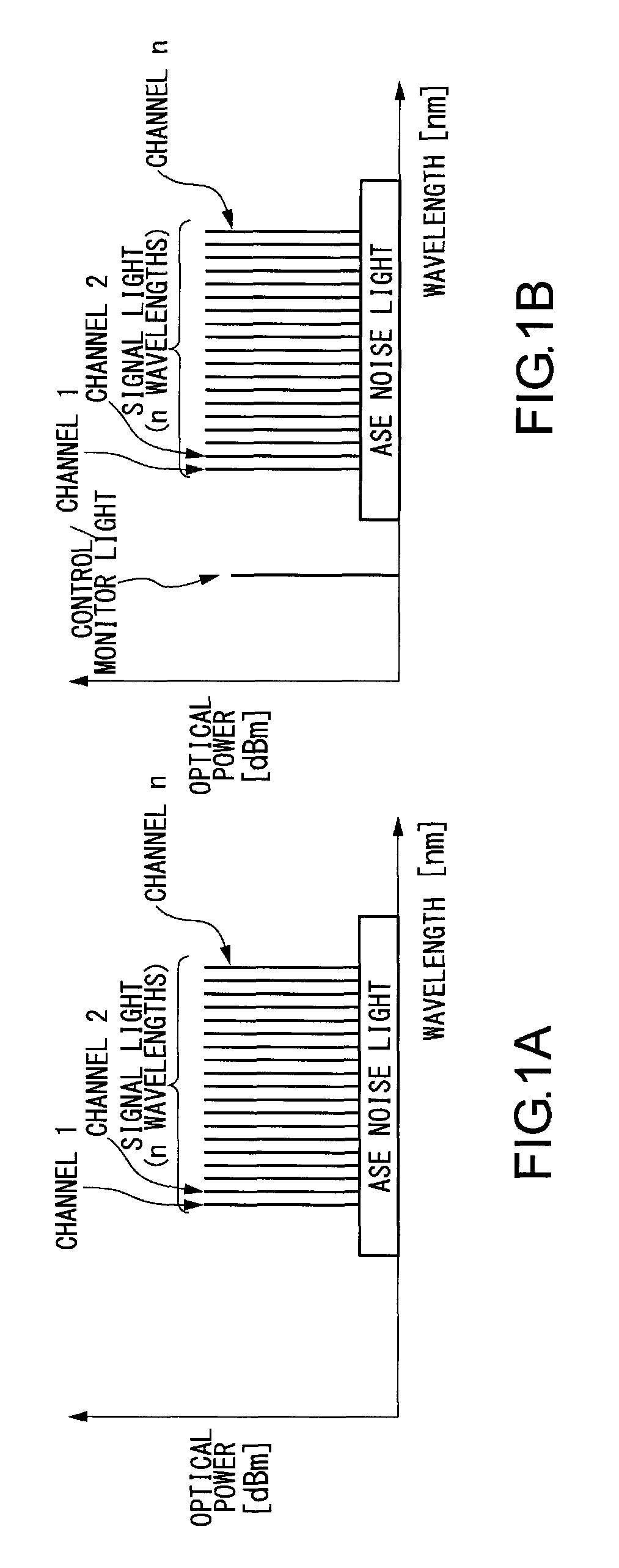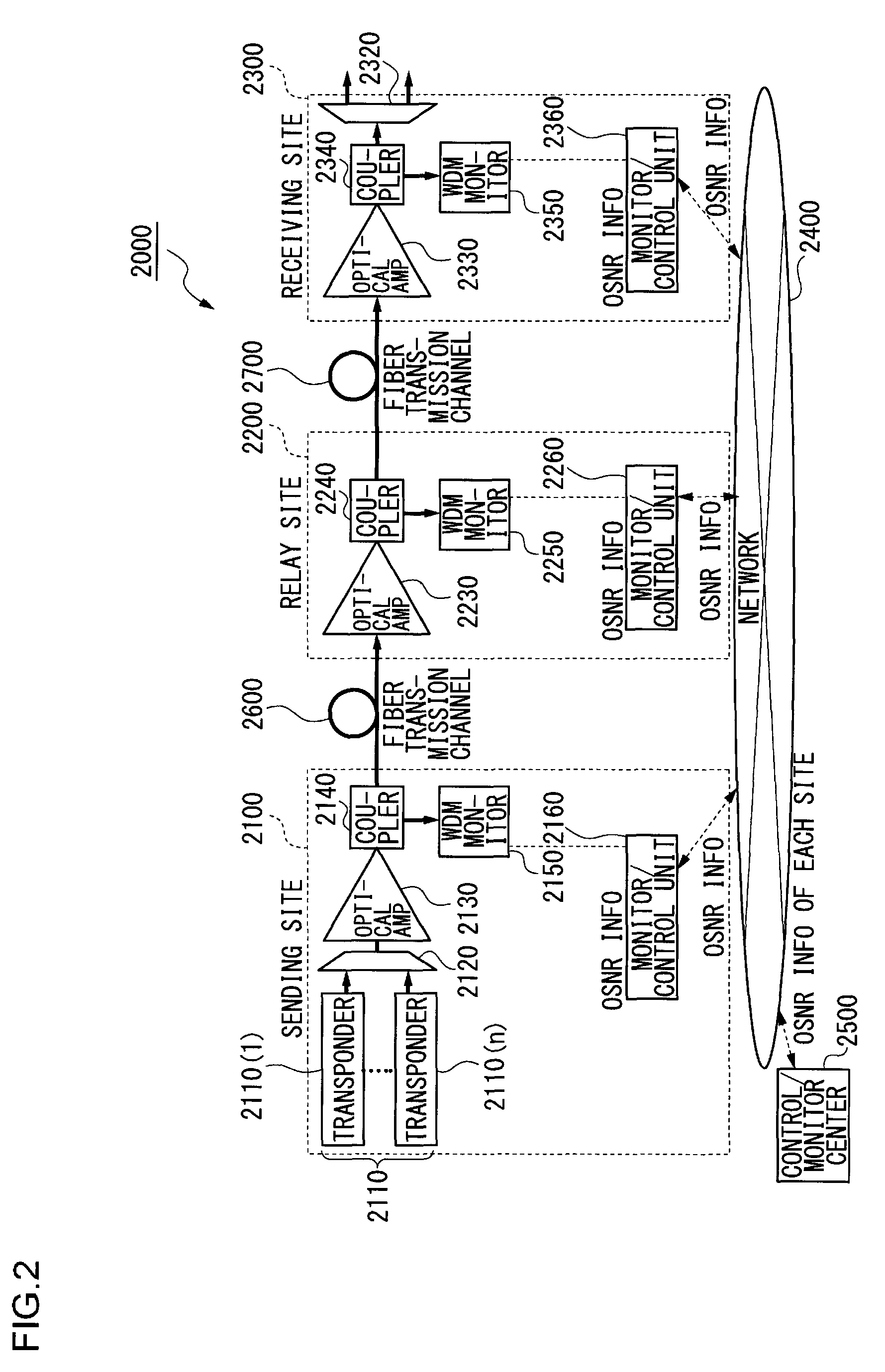Wavelength division multiplexing transmission system and apparatus and optical signal noise ratio calculation method
a transmission system and wavelength division technology, applied in the field of wavelength division multiplexing transmission systems, wavelength division multiplexing transmission apparatuses, optical signal noise ratio calculation methods, can solve the problems of inability to accurately measure osnr, inability to obtain accurate noise optical power, and increase of bit error rate (ber), so as to reduce the effect of sideband
- Summary
- Abstract
- Description
- Claims
- Application Information
AI Technical Summary
Benefits of technology
Problems solved by technology
Method used
Image
Examples
first embodiment
[0067][First Embodiment]
[0068]FIG. 4 to FIG. 6 are block diagrams illustrating the structure of WDM transmission systems according to some embodiments of the present invention. The same reference numerals used in FIG. 4 to FIG. 6 denote the same elements in FIG. 2 and FIG. 3 and thus a detailed explanation of such elements is omitted. In the WDM transmission systems shown in FIG. 4 to FIG. 6, a wavelength multiplexer (also referred to as a mux / demux) at a sender site wavelength-multiplexes each signal light from transponders, and a coupler (also referred to as an optical branching unit), which is arranged in front of an optical fiber, branches the wavelength-multiplexed optical signal to give the branched signal to a WDM monitor.
[0069]In the WDM transmission system 4000 in FIG. 4, the transmission apparatus 4100 at the sender site obtains OSNRsn information from the signal light branched by the coupler 2140 in front of the optical amplifier 2130. Hereinafter, the lowercase character...
second embodiment
[0097][Second Embodiment]
[0098]The WDM transmission systems 4000 and 5000 shown in FIG. 4 and FIG. 5 respectively are of a typical structure for notifying the OSNRsn information to the downstream transmission apparatus 4200, 4300 of the relay site or the receiving site by using the control / monitor light. On the other hand, the WDM transmission system 6000 of FIG. 6 is of a typical structure for notifying the OSNRsn information to the downstream relay site or receiving site via the monitor / control units 2260, 2360 and the network 240.
[0099]The WDM transmission system 5000 of FIG. 5 differs from the WDM transmission system 4000 in that the OSNRsn information received via the control / monitor light transmission units 4170 and 4270 is notified to the monitor / control unit 2260 and the process for computing the corrected OSNRn is performed in the monitor / control unit 2260.
[0100]In the WDM transmission system 5000, the WDM monitor 4250 is not notified of the OSNRsn information and the WDM m...
third embodiment
[0104][Third Embodiment]
[0105]FIG. 15 is a block diagram illustrating the WDM transmission system 14000 where the light is branched from the coupler 2140 attached to the output terminal of the optical amplifier 2130 in the transmission apparatus e100 of the sending site and the branched light is input to the WDM monitor 2150. The WDM transmission system 14000 is preferable in that the common arrangement and structure of the optical amplifiers 2230, 2330 and the couplers 2240, 2340 in the transmission apparatuses e200, e300 of the relay site and the receiving site can be adopted.
[0106]In the WDM transmission system 14000 shown in FIG. 15, the OSNRs′n measured by the WDM monitor 2150 contains the ASE component of the optical amplifier 2130 that corresponds to a sending amplifier. The measurement unit is dB and “n” indicates the channel number (1 to the number of the wavelengths).
[0107]Therefore, the value of OSNR″n that corresponds to the ASE component of the optical amplifier 2130 is...
PUM
 Login to View More
Login to View More Abstract
Description
Claims
Application Information
 Login to View More
Login to View More - R&D
- Intellectual Property
- Life Sciences
- Materials
- Tech Scout
- Unparalleled Data Quality
- Higher Quality Content
- 60% Fewer Hallucinations
Browse by: Latest US Patents, China's latest patents, Technical Efficacy Thesaurus, Application Domain, Technology Topic, Popular Technical Reports.
© 2025 PatSnap. All rights reserved.Legal|Privacy policy|Modern Slavery Act Transparency Statement|Sitemap|About US| Contact US: help@patsnap.com



